|
|
|
Sort Order |
|
|
|
Items / Page
|
|
|
|
|
|
|
| Srl | Item |
| 1 |
ID:
151756
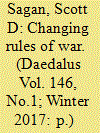

|
|
|
| 2 |
ID:
151763


|
|
|
|
|
| Summary/Abstract |
A basic dilemma for political transitions and peace talks, whether to hold perpetrators of mass atrocities accountable or to negotiate a deal, has once again become the source of intense political controversy. Originally seen as containing a pathbreaking and innovative solution to this problem, a peace deal designed to bring an end to the war between the government of Colombia and the FARC was instrumentalized by former President Uribe to mobilize popular support and was struck down when it was put to the public for a vote. Elsewhere, political realities have impinged on efforts to hold trials, provoking a backlash by powerful individuals determined to spoil the peace rather than sacrifice their personal freedom. But when international criminal tribunals fail to prosecute powerful spoilers, they have been condemned for their hypocrisy or charged with being selective in their pursuit of justice. One measure to address the basic accountability dilemma would be to accept transitional justice compromises that hold a reasonable prospect of delivering peace and that have a strong base of support among those individuals and communities most affected by political violence. Transitional justice strategies should be guided by a do-no-harm principle.
|
|
|
|
|
|
|
|
|
|
|
|
|
|
|
|
| 3 |
ID:
151766


|
|
|
|
|
| Summary/Abstract |
Most civilian casualties in war are not the result of direct exposure to bombs and bullets; they are due to the destruction of the essentials of daily living, including food, water, shelter, and health care. These “indirect” effects are too often invisible and not adequately assessed nor addressed by just war principles or global humanitarian response. This essay suggests that while the neglect of indirect effects has been longstanding, recent technical advances make such neglect increasingly unacceptable: 1) our ability to measure indirect effects has improved dramatically and 2) our ability to prevent or mitigate the indirect human toll of war has made unprecedented progress. Together, these advances underscore the importance of addressing more fully the challenge of indirect effects both in the application of just war principles as well as their tragic human cost in areas of conflict around the world.
|
|
|
|
|
|
|
|
|
|
|
|
|
|
|
|
| 4 |
ID:
151764
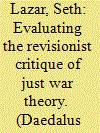

|
|
|
|
|
| Summary/Abstract |
Modern analytical just war theory starts with Michael Walzer's defense of key tenets of the laws of war in his Just and Unjust Wars. Walzer advocates noncombatant immunity, proportionality, and combatant equality: combatants in war must target only combatants; unintentional harms that they inflict on noncombatants must be proportionate to the military objective secured; and combatants who abide by these principles fight permissibly, regardless of their aims. In recent years, the revisionist school of just war theory, led by Jeff McMahan, has radically undermined Walzer's defense of these principles. This essay situates Walzer's and the revisionists’ arguments, before illustrating the disturbing vision of the morality of war that results from revisionist premises. It concludes by showing how broadly Walzerian conclusions can be defended using more reliable foundations.
|
|
|
|
|
|
|
|
|
|
|
|
|
|
|
|
| 5 |
ID:
151758
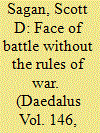

|
|
|
|
|
| Summary/Abstract |
This essay analyzes the extraordinary drawings of Red Horse, a Minneconjou warrior who fought at the 1876 Battle of the Little Bighorn, to provide insights into what warfare was like without just war doctrine or the laws of armed conflict to place constraints on violence. The artist's candid vision of the battle and its aftermath portrays the indiscriminant brutality of the Great Sioux War, the disrespect given to a hated enemy, and the lingering desire for revenge. But the drawings also reveal the pride of victory and the trauma of defeat. In addition to providing a window into the past, the Red Horse drawings provide a lens to help us understand the atrocities committed by the Islamic State and Al Qaeda today and a mirror that can help us more clearly see ourselves.
|
|
|
|
|
|
|
|
|
|
|
|
|
|
|
|
| 6 |
ID:
151760


|
|
|
|
|
| Summary/Abstract |
A central element of the dominant view of just war theory is the moral equality of soldiers: combatants have equal rights to wage war against one another and are entitled to certain protections if captured, without regard to which side's cause of war is just. But whether and how this principle should apply in asymmetric armed conflicts between states and nonstate groups is profoundly unsettled. I argue that we should confer war rights on fighters for nonstate groups when they are engaged in violence that has risen to the level of armed conflict, and when the state against which the war is being waged is not entitled to assert its monopoly on the legitimate exercise of force, either because 1) the nonstate group has established sufficient control over territory to assert its own governing authority; or 2) because the group is located abroad. Conferring war rights on nonstate fighters does not, however, permit them to engage in acts that violate the laws of war. Fighters who commit such violations are individually subject to prosecution without regard to their group's entitlement to war rights.
|
|
|
|
|
|
|
|
|
|
|
|
|
|
|
|
| 7 |
ID:
151759
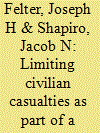

|
|
|
|
|
| Summary/Abstract |
Military commanders in wartime have moral obligations to abide by international norms and humanitarian laws governing their treatment of noncombatants. How much risk to their own forces they must take to limit harm to civilians in the course of military operations, however, is unclear. The principle of proportionality in the law of armed conflict all but necessitates that they make a utilitarian calculation: potential harm to civilians must always be balanced against military value when considering actions that could hurt innocents. In asymmetric conflicts, such as most counterinsurgencies, information flows, collaboration, and ultimately the support of the local population can be key to achieving strategic objectives. Thus, limiting casualties to noncombatants and other actions that alienate the population in these types of conflicts is a key part of a winning strategy. The concept of “courageous restraint” was created to express this principle to NATO and U.S. forces fighting in Afghanistan.
|
|
|
|
|
|
|
|
|
|
|
|
|
|
|
|
| 8 |
ID:
151761
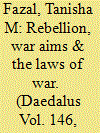

|
|
|
|
|
| Summary/Abstract |
Most wars today are civil wars, but we have little understanding of the conditions under which rebel groups might comply with the laws of war. i ask three questions in this essay: What do the laws of war require of rebels, or armed nonstate actors (ansas)? To what extent are rebels aware of the laws of war? Under what conditions do rebel groups comply with international humanitarian law? i argue that the war aims of rebel groups are key to understanding their relationship with the laws of war. In particular, secessionist rebel groups – those that seek a new, independent state – are especially likely to comply with the laws of war as a means to signal their capacity and willingness to be good citizens of the international community to which they seek admission.
|
|
|
|
|
|
|
|
|
|
|
|
|
|
|
|
| 9 |
ID:
151762


|
|
|
|
|
| Summary/Abstract |
An enduring dilemma in war is whether and how to punish those responsible for war crimes. In this essay, we analyze the most frequent criticisms made by war crimes trial skeptics, including the claims that such trials endanger prospects for peace by encouraging enemies to continue fighting, that they achieve only “victors’ justice” rather than real justice, and that, in any event, they are unnecessary due to the existence of more effective and less costly alternatives. We conclude, in accordance with a “moderate retributivism,” that when carried out consistently with established law and procedure, and when not dramatically outweighed by concerns that trials will exacerbate ongoing or future conflicts, prosecutions are a legitimate, and sometimes necessary, response to violations of the laws of war and international criminal law more broadly.
|
|
|
|
|
|
|
|
|
|
|
|
|
|
|
|
| 10 |
ID:
151757


|
|
|
|
|
| Summary/Abstract |
This essay aims to redescribe key moments in the history of American military engagements to account for a persistent role that law has played in these conflicts. The law of war tradition has persisted since the War of Independence, we argue, because of an internal dynamic that makes it both strategically useful and costly for the United States to commit itself to rule-bound warfare. Invoking the laws of war to advance the strategic interests of the United States, American soldiers and statesmen have found, entails consequences beyond their control, making reversals in position more costly and enabling critiques in the language of the law. These entailments, we argue, are built into the enduring strategic value of the laws of war. The law has remained useful not because it can claim perfect neutrality, but because it has force independent of the interests for which it is mobilized.
|
|
|
|
|
|
|
|
|
|
|
|
|
|
|
|
| 11 |
ID:
151765
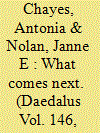

|
|
|
|
|
| Summary/Abstract |
Wars do not end when the last shot is fired. War planning has failed to demonstrate an understanding that victory requires consolidation and the emergence of a more healthy society. The most prominent recent example is the Second Iraq War, but the failure reaches back to the American Civil War. This essay is less concerned with the moral obligation to reconstruct after war than the practical necessity of jus post bellum. In order to learn how to achieve such a consolidation of military victory, a shift in mindset is required from both civil and military policy-makers and planners. A change in practice is required at the very beginning of planning for war. “Whole of government” has been an empty phrase, but experience dictates that an unprecedented degree of domestic and international cooperation is required.
|
|
|
|
|
|
|
|
|
|
|
|
|
|
|
|
|
|
|
|
|